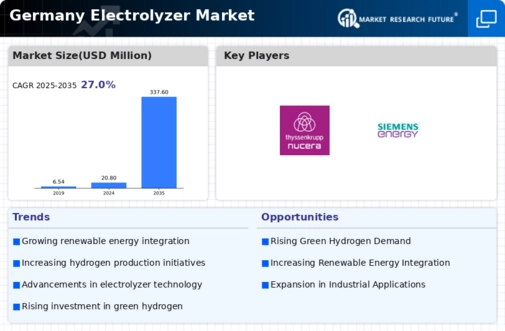Market Growth Projections
The Global Germany Electrolyzer Market Industry is projected to experience substantial growth over the next decade. With a market value of 1500 USD Million in 2024, it is anticipated to reach 5000 USD Million by 2035. This growth trajectory suggests a compound annual growth rate of 11.57% from 2025 to 2035, reflecting the increasing adoption of electrolyzer technologies across various sectors. The market dynamics are influenced by factors such as rising demand for green hydrogen, government support, and technological advancements. These projections indicate a robust future for the electrolyzer market, positioning it as a key player in the global energy transition.
Rising Demand for Green Hydrogen
The Global Germany Electrolyzer Market Industry is experiencing a surge in demand for green hydrogen, driven by the global shift towards renewable energy sources. As countries aim to reduce carbon emissions, electrolyzers play a crucial role in producing hydrogen from renewable energy. In 2024, the market is projected to reach 1500 USD Million, reflecting the increasing investments in hydrogen production technologies. This trend is likely to continue as governments and industries recognize the potential of hydrogen as a clean energy carrier, further propelling the market growth. By 2035, the market could expand to 5000 USD Million, indicating a robust trajectory fueled by the global energy transition.
Government Initiatives and Support
The Global Germany Electrolyzer Market Industry benefits significantly from government initiatives aimed at promoting hydrogen technologies. Various policies and funding programs are being implemented to support research and development in electrolyzer technologies. For instance, Germany's National Hydrogen Strategy outlines ambitious targets for hydrogen production, which directly influences the market landscape. These initiatives not only provide financial backing but also create a favorable regulatory environment for the deployment of electrolyzers. As a result, the market is expected to witness a compound annual growth rate of 11.57% from 2025 to 2035, driven by sustained government support and strategic investments.
Increasing Industrial Applications of Hydrogen
The Global Germany Electrolyzer Market Industry is witnessing an increase in industrial applications for hydrogen, which is driving market growth. Industries such as steel manufacturing, chemical production, and transportation are increasingly adopting hydrogen as a cleaner alternative to traditional fuels. This shift is indicative of a broader trend towards decarbonization across various sectors. The versatility of hydrogen as a feedstock and energy source enhances its appeal, potentially leading to a significant rise in electrolyzer installations. As industries seek to meet stringent environmental regulations, the demand for electrolyzers is expected to grow, further solidifying the market's position in the global energy landscape.
Technological Advancements in Electrolyzer Design
Technological advancements in electrolyzer design are pivotal for the Global Germany Electrolyzer Market Industry. Innovations such as improved materials and enhanced efficiency are leading to the development of more cost-effective and durable electrolyzers. These advancements are crucial for reducing the overall cost of hydrogen production, making it more competitive with fossil fuels. As technology continues to evolve, the market is likely to see a proliferation of advanced electrolyzer systems that cater to various industrial applications. This trend not only supports the growth of the market but also aligns with global efforts to achieve sustainable energy solutions.
Growing Investment in Renewable Energy Infrastructure
The Global Germany Electrolyzer Market Industry is poised for growth due to increasing investments in renewable energy infrastructure. As countries prioritize the transition to sustainable energy sources, significant capital is being allocated to develop wind, solar, and other renewable energy projects. This investment is critical for the production of green hydrogen, as electrolyzers require a stable and abundant supply of renewable energy. The ongoing expansion of renewable energy capacity is likely to create a favorable environment for electrolyzer deployment, thereby enhancing market prospects. The synergy between renewable energy and hydrogen production is expected to drive substantial growth in the coming years.













Leave a Comment